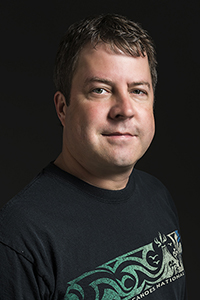You’re accessing archived content
This is archived content from the UIT website. Information may be outdated, and links may no longer function. Please contact stratcomm@it.utah.edu if you have any questions about archived content.
IT Leadership Spotlight: Tom Cheatham, director, Center for High Performance Computing (CHPC)

Tom Cheatham, CHPC Director
Where are you from originally?
I grew up in the Boston area in the historical town of Lexington, Massachusetts (i.e., "Shot heard round the world"), next door to the Hancock-Clarke house.
What post-secondary degree(s) do you have, in what subjects, and from which school(s)?
I hold a B.A. in Mathematics and Computer Science, and a B.A. in Chemistry (Honors) from Middlebury College in Vermont. I also obtained a Ph.D. in Pharmaceutical Chemistry from UCSF with Peter Kollman, and I was a National Research Council fellow at the National Institutes of Health with Bernie Brooks.
What led you to the University of Utah?
Two-body issues with my wife, whom I met in graduate school, led us to the U. She had three tenure-track faculty position offers, including one at Utah in Pharmaceutics. I did not. Medicinal Chemistry, working with CHPC, VPR Koehn, and the College of Pharmacy created a research professor track position with a modest start-up package for me, so we moved to Utah in January 2000. Being a significant user of large-scale computational resources, I was strongly attracted to CHPC, its people and its resources. Both my wife and I eventually made it through the grueling and humbling tenure-track process and finally through promotion to full professor.
Can you describe the path you took to IT leadership?
This is complicated, but is related to constant critiques I received during the tenure-track process, namely that I engage in too many service activities. Service activities, however, defined this path. Locally, this was ITC, many campus committees on research computing, and later the research computing portfolio. Now I lurk at IT Pros, ANTC and SITC. Nationally, I was involved in the NSF supercomputer centers as a user/student and then teacher, then on the AAB/Teragrid allocations committee, eventually Chair of allocations, NSF Cyberinfrastructure User Advisory Committee, Teragrid Science Advisory Committee and later Chair, XSEDE Senior Management Team, XSEDE Science Advisory Board, and Chair of the XSEDE User Advisory Commmitee, International HPC Summer School, Blue Waters Petascale Resource Science and Engineering Team Advisory Council, ACI-REF PI Chair, PEARC Steering Committee, Utah Education Network Advisory Council, Rocky Mountain Advanced Computing Consortium Vice-Chair, Campus Research Computing Consortium (CaRCC) Council Chair, etc.
How would you describe your leadership style and/or philosophy?
Collaborative, open, transparent, critical, technology aware, and trying to be inclusive and consensus-driven. Change is good; especially if it will lead to obvious improvement and innovation. If we can deploy new or needed capabilities, and/or save money, why not pursue the change? I prefer a flat leadership structure with smaller projects with engaged project leads, regardless of rank.
What do you enjoy most about your role?
Research is slow and challenging, and although I am well-published, the slow pace of advancement and constant battles for funding was wearing me down. At the same time, I was getting more engaged at the national level in supporting and advocating for research computing, so why not try this at home? So, I applied for CHPC director position as a straw-man candidate representing campus in a national search and was selected. Now, with the excellent, experienced, technical and facilitator rich team at CHPC, we get to engage many researchers, enable their research on innovative and cost-effective compute and data resources, and see advancement of amazing research across varied domains at a faster pace. This is very rewarding, and will be even more rewarding if we can sustain research computing efforts.
What do you find most challenging about your role at the U?
Leading the CHPC team is fantastic. However, in other interactions both locally and nationally, it is very difficult to change mindsets, to admit limitations, and to be dismissed. This is very frustrating. It is also challenging to compromise or to give in to others even when you think you are doing the right thing. I am still learning about what it means to lead and to be an effective leader while also learning through experience what is not effective.
What are some of your hobbies?
Cooking, eating, travel, hiking, mountain biking, snorkeling and skiing.
Is there a fun fact about yourself that you'd like to share?
I am still active in research and for the past few years have had one of the largest computer time allocations on the Blue Waters Petascale resource at the University of Illinois. As a kid, we had a PDP-10 and Commodore Pet computers in our high school. We had a VAX in college, and I got to work with Apollo workstations serial #1 and #2 and the Connection Machine (seen in Jurassic Park or in the NYC MOMA), the MasPar-1, and NeXT machines at Harvard. I was able to work with thermal printers and have the pre-release Macintosh with its famous "phone book" manual at home that Apple gave my father. However, these are not fun facts. Maybe that I was a choirboy in my youth and even have an LP?
Is there anything else you think readers would like to know about you?
I want to enable, optimize, advocate for, and improve the IT experience on campus as best I can.
Previous UIT Leadership Spotlights: Ken Pink and Lisa Kuhn.
Node 4
Our monthly newsletter includes news from UIT and other campus/ University of Utah Health IT organizations, features about UIT employees, IT governance news, and various announcements and updates.
